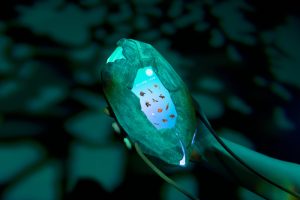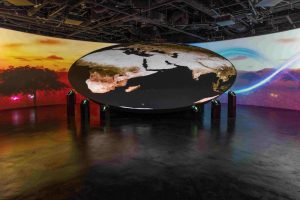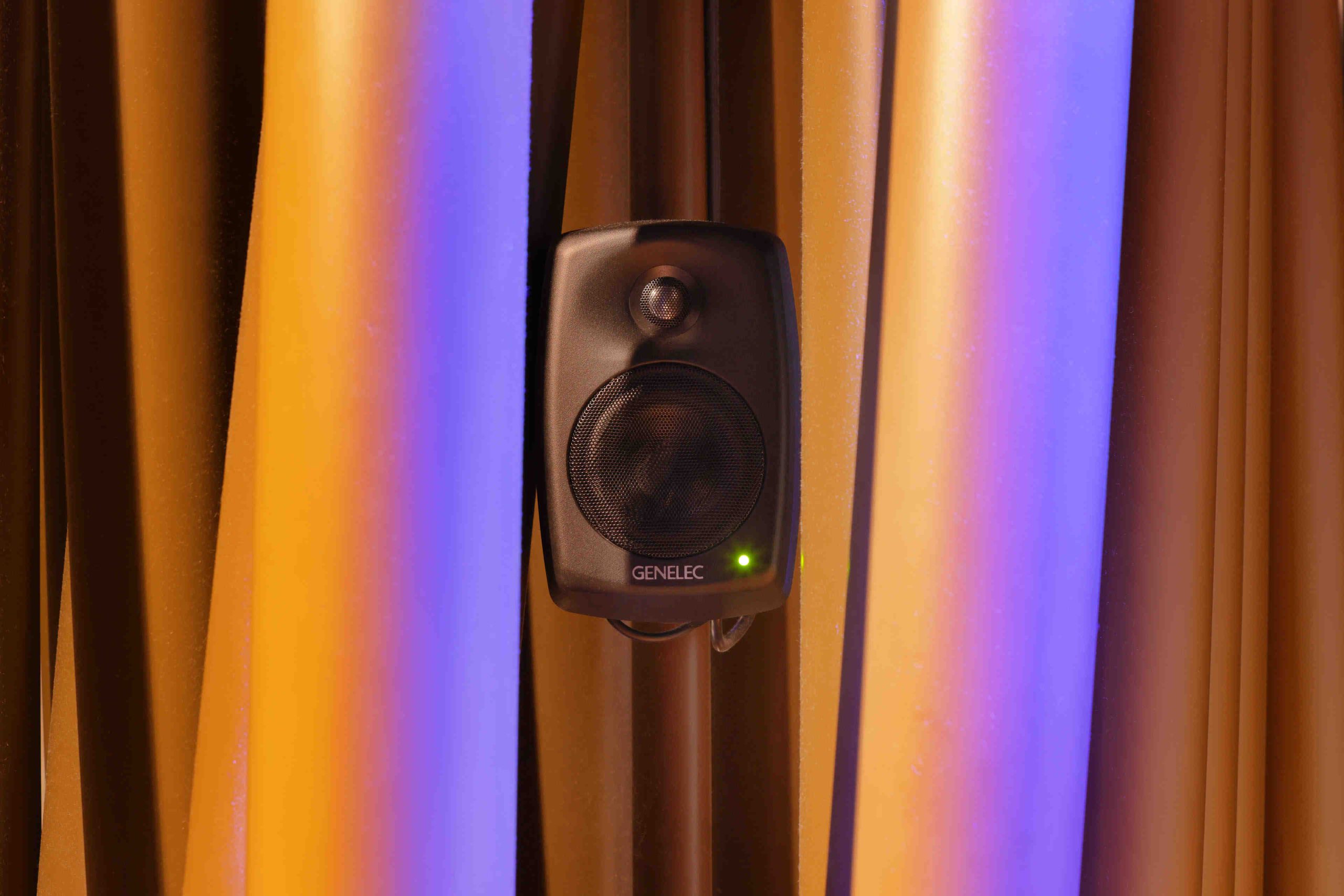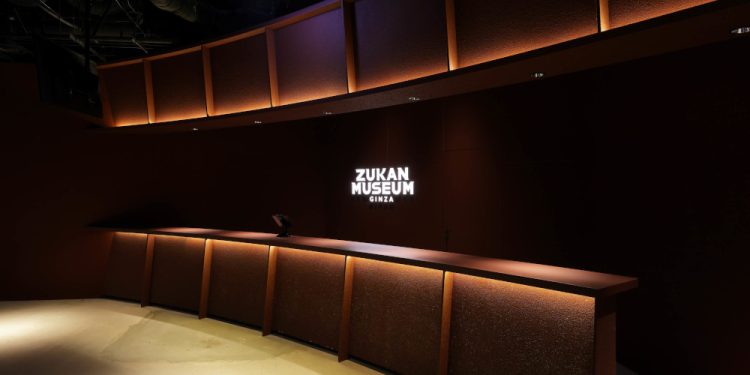Inspired by Shogakukan’s NEO series of picture books, Zukan Museum is an immersive journey into the world of living things.
The modern museum experience is a far cry from the dusty, static exhibits of yesteryear that would only interest the most passionate of visitors. Today, a trip to the museum is a treat for all ages, offering us the chance to be plunged into alternative realities as part of an experience designed to entertain as well as educate. The Zukan Museum Ginza in Tokyo is no exception. Located on the 6th floor of the vast Tokyu Plaza Ginza shopping mall, the Zukan Museum is described as an ‘experience-based facility’ that fuses the digital and the real, offering an immersive and interactive journey to discover the natural world beyond time and space. Over 100 Genelec loudspeakers combined with cutting-edge video technology help drive the experience where natural environments of forests and water are seamlessly connected for a magical journey through the world of living things.
“Designed as an experiential entertainment space that can be enjoyed by people of all ages, the main concept is to encourage visitors to actively seek out information for themselves and go beyond the passive experience of simply being given information,” says Takayuki Kitai of AID-DCC Inc – who was involved in the overall creative process of the facility.
 Once inside the museum, visitors are given a ‘recording stone’, which helps them navigate the experience and record the information they choose. They then set out on a journey into the world of illustrated books, created using state-of-the-art audio-visual technology. 24 hours are condensed into 60 minutes, allowing visitors to experience the natural world as time passes from early morning right through into the night. Information can be recorded along the journey as it leads to a grand finale.
Once inside the museum, visitors are given a ‘recording stone’, which helps them navigate the experience and record the information they choose. They then set out on a journey into the world of illustrated books, created using state-of-the-art audio-visual technology. 24 hours are condensed into 60 minutes, allowing visitors to experience the natural world as time passes from early morning right through into the night. Information can be recorded along the journey as it leads to a grand finale.
“The museum faithfully recreates the ecosystem of the natural world, with different creatures appearing in each area, such as the forest, savanna, underwater, etc., where the act of observing and recording the creatures is interactive. For example, if you get too close to a creature, it will be startled and run away,” explains Jun Fujiwara of invisi Ltd –who handled the sound production and UX design. Kitai goes on to elaborate: “This is a world in which living creatures are the main focus. As such, the element of sound is just as important as the visual aspect in recreating the feeling that these creatures are actually there.”
“The acoustical element is made up of three components: sounds produced by living creatures; background environmental sounds; and musical elements,” describes Takashi Miyamoto of coton Inc – who was responsible for implementing the audio system and sound design. “The environment changes according to the time of day, just as it does in the real world. In particular, the musical elements are generated using coton’s original music generation technology called ‘soundtope’ – a programme that is closely attuned to human emotions, which are, of course, influenced by the environment. Soundtope automatically generates the most appropriate music based on the season and time of day for a truly authentic experience.”
These three acoustical elements, with a total of 150 channels of sound, create different worlds in each of the multiple areas within the museum. There is no physical separation between areas, so it was particularly important to ensure that transitions from one area to another are smooth and coherent.
 “In order to compose the sound so that it would be seamlessly connected without any boundaries, we used a common tonal scale between adjacent areas to prevent sounds from clashing with each other,” continues Miyamoto. “Furthermore, in terms of timbre, the placement of intermediate common tones between areas has the effect of a boundary partition, like a sound curtain. Another acoustical issue that emerged was the panning system, which pans the sound produced by the creatures. The loudspeaker arrangements didn’t allow us to use existing panners, so we had to develop our own panning system.”
“In order to compose the sound so that it would be seamlessly connected without any boundaries, we used a common tonal scale between adjacent areas to prevent sounds from clashing with each other,” continues Miyamoto. “Furthermore, in terms of timbre, the placement of intermediate common tones between areas has the effect of a boundary partition, like a sound curtain. Another acoustical issue that emerged was the panning system, which pans the sound produced by the creatures. The loudspeaker arrangements didn’t allow us to use existing panners, so we had to develop our own panning system.”
Fujiwara continues: “This panning system allowed us to focus on the sound of the creatures after they were out of the frame. In other words, we were able to blend into the space the sound of their footsteps and wings gradually fading away. This is also a mechanism to give visitors a sense of depth and expanse similar to that of the natural world, without the spatial constraints of being inside a building. Conversely, when a creature enters the frame, we can hear its approach beforehand, emphasising the “presence” of the creature and fostering a sense of excitement and willingness to explore before the actual encounter. We were able to realise this plan thanks to our ability to expand the panning area and the excellent localisation characteristics of Genelec loudspeakers. In the real world, actual sounds generated by living creatures, such as squeals and footsteps, differ slightly every time, so we prepared 10 to 30 different sound sources for each, and played them randomly in a single shot to create a sense of reality as an auditory experience. The museum has over 2,000 files of sound sources – I think that this variety of sounds is one of the factors that increases the resolution of the experience.”
According to Miyamoto, the excellent localisation achieved by Genelec loudspeakers with the panning was the deciding factor in deploying them at the museum, along with their extremely accurate sound reproduction. “Other loudspeakers used different mechanisms to achieve localisation, but that was problematic in multichannel setups, and in general, they lacked the accurate sound reproduction we were looking for. Genelec’s superlative acoustic characteristics and flexible installation were a major attraction.” Fujiwara agrees: “As we wanted to prioritise the atmosphere of the museum, we tried to make the loudspeakers as invisible as possible. We explored various options, including high positions on the ceiling and gaps in the structure. This meant the loudspeakers had to be as small as possible – and when it came to the size/ performance ratio, Genelec was the obvious choice.”
 At the Zukan Museum, 85 of the 8010 compact active studio loudspeakers, 23 of the slightly larger 8020 models, and seven 7360 subwoofers were installed throughout the space. The 8010 is used widely throughout the museum due to its combination of exceptional performance and small footprint, while the 8020 is used specifically for reproducing creature sounds – which requires more low-end. In addition, Genelec’s huge range of accessories proved ideal for the project, with the 8000-420CB short wall mount and 8000-416B truss mount both employed to achieve flexible installation tailored to the space.
At the Zukan Museum, 85 of the 8010 compact active studio loudspeakers, 23 of the slightly larger 8020 models, and seven 7360 subwoofers were installed throughout the space. The 8010 is used widely throughout the museum due to its combination of exceptional performance and small footprint, while the 8020 is used specifically for reproducing creature sounds – which requires more low-end. In addition, Genelec’s huge range of accessories proved ideal for the project, with the 8000-420CB short wall mount and 8000-416B truss mount both employed to achieve flexible installation tailored to the space.
“To create the world where living creatures inhabit, we received supervision from emeritus university professors and other experts,” observes Kitai. “We believe that we managed to provide an experience unique to this museum that cannot be obtained in conventional facilities. Since its opening, the museum has received favourable reviews from various fields as a new form of experiential facility. I hope many people will experience it.”





















